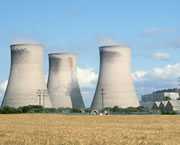Cooling Towers
What is a cooling tower?
A cooling tower is designed to remove heat from a building or facility by spraying water down through the tower to exchange heat into the inside of the building. Air comes in from the sides of the tower and passes through the falling water. As the air passes through the water, heat is exchanged and some of the water evaporates. This heat and evaporated water flow out the top of the tower in the form of a fine cloud-like mist. The cooled water is collected at the bottom of the tower and pumped back into the plant or building for reuse. Cooling towers provide large scale air-conditioning where land and (or) water are expensive, or regulations prohibit the return of once-through cooling waters 1.
What are cooling towers used for?

Cooling towers are primarily used for heating, ventilation, and air conditioning (HVAC) and industrial purposes. Cooling towers provide a cost-effective and energy efficient operation of systems in need of cooling. More than 1,500 industrial facilities use large quantities of water to cool their plants 2. HVAC systems are used typically in large office buildings, schools, and hospitals. Industrial cooling towers are larger than HVAC systems and are used to remove heat absorbed in the circulating cooling water systems used in power plants, petroleum refineries, petrochemical plants, natural gas processing plants, food processing plants, and other industrial facilities.
Cooling towers and Legionnaires’ disease
Cooling towers contain large amounts of water and are potential breeding grounds for Legionella bacteria if they are not properly disinfected and maintained. Water within cooling towers is heated via heat exchange, which is an ideal environment for Legionella heat-loving bacteria to grow. Legionnaires’ disease can be acquired when an individual breathes in water droplets containing Legionella bacteria. The disease was named in 1976, when American Legion members who attended a Philadelphia convention, suffered from an unusual pneumonia (lung infection). Outbreaks due to Legionnaires’ disease from contaminated cooling towers still occur today 3.
References
- Page last reviewed: July 12, 2017
- Page last updated: July 12, 2017
- Content source:


 ShareCompartir
ShareCompartir